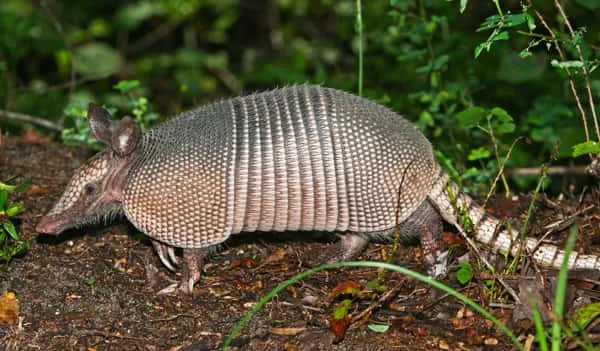I was driving from Cadiz to Hopkinsville on Highway 68-80 today when I saw an unfamiliar creature lying on the side of the road. It had obviously been hit by a car. At first. I thought it was a possum since it was about the same size.
But this was an armadillo. Only a few minutes before this, a friend had told me of seeing two armadillos lying dead on I-24. So I started looking for information on this new animal I had never seen before. I found that this strangely configured new critter that is beginning to take up residence in Kentucky is the nine banded armadillo. I was shocked to find that the armadillos first appeared in western Kentucky more than 20 years ago when the first report was a road kill in Aurora, Ky.
I was shocked to find that the armadillos first appeared in western Kentucky more than 20 years ago when the first report was a road kill in Aurora, Ky.
The first confirmed sighting of a live armadillo in Land Between the Lakes was in the spring of 2002 when a farmer on a tractor saw one feeding at the edge of a field. People associate Land Between the Lakes with eagles, pelicans, white-tail deer, turkeys, and now – armadillos. Our region boasts the largest population of the nine-banded armadillo in the Commonwealth of Kentucky and they are expanding their range. A number of hard freezing winters would make armadillo survival extremely difficult and that may be the only thing that will slow the armadillos’ natural, northern progression. Kentucky Department of Fish & Wildlife Resources has placed armadillos on their “invasive species” list. But what biologists can’t agree on is why range expansion is occurring so fast.
 Factors that may be fueling this expansion include: climate change, the armadillo’s general adaptability, its high reproductive rate and little desire on the part of humans to hunt or eat armadillos. The armadillo’s armored appearance makes it look reptilian, but this almost hairless animal is a mammal. Armadillos sport fine tracts of hair, are warm blooded, give live births, and feed their young milk. Unique among mammals, armadillos give birth to four identical quadruplets every time. Armadillos belong to a group of mammals found only in the Americas. A common joke describes armadillos as “possums in a half shell.” They’re actually related to anteaters and sloths while opossums are marsupials, like kangaroos. Whatever the reason for the expansion, they are leaving their traditional strongholds of the Deep South for more temperate regions north of the Mason Dixon line.
Factors that may be fueling this expansion include: climate change, the armadillo’s general adaptability, its high reproductive rate and little desire on the part of humans to hunt or eat armadillos. The armadillo’s armored appearance makes it look reptilian, but this almost hairless animal is a mammal. Armadillos sport fine tracts of hair, are warm blooded, give live births, and feed their young milk. Unique among mammals, armadillos give birth to four identical quadruplets every time. Armadillos belong to a group of mammals found only in the Americas. A common joke describes armadillos as “possums in a half shell.” They’re actually related to anteaters and sloths while opossums are marsupials, like kangaroos. Whatever the reason for the expansion, they are leaving their traditional strongholds of the Deep South for more temperate regions north of the Mason Dixon line.
What are the implications of another small, opportunistic, mammal in our ecosystem? Hopefully, the result of a new species won’t be dramatic, but for ground-nesting song and gamebirds any new animal willing to plunder a nest is not good news. Likewise, the effect of the armadillo’s rooting around sensitive native plants won’t be known until a sizable population develops.  Armadillos can cause a lot of damage in gardens and lawns. They’re grubbers; they destroy yards, root through gardens and build tunnels. They are built for burrowing with smooth bodies, strong forearms, and large claws. They are not after your tomatoes or petunias; armadillos eat insects. They eat the Japanese beetle grubs under your lawn, the yellow jackets near the old stump, or the termites in the wood pile. They sleep 16 hours a day and use that long, sticky tongue to eat 200 pounds of insects a year. That’s good. But there is the leprosy thing. A small percentage of armadillos do carry leprosy.
Armadillos can cause a lot of damage in gardens and lawns. They’re grubbers; they destroy yards, root through gardens and build tunnels. They are built for burrowing with smooth bodies, strong forearms, and large claws. They are not after your tomatoes or petunias; armadillos eat insects. They eat the Japanese beetle grubs under your lawn, the yellow jackets near the old stump, or the termites in the wood pile. They sleep 16 hours a day and use that long, sticky tongue to eat 200 pounds of insects a year. That’s good. But there is the leprosy thing. A small percentage of armadillos do carry leprosy.
This population is located mostly in the Deep South and Florida. Luckily, modern hygiene and antibiotics provide the best weapons against armadillos transmitting leprosy. According to the Center for Disease Control, the risk is low for catching leprosy from an armadillo. It is said that the only way it can be transferred from them to humans is if the human eats undercooked armadillo meat. Make sure, says cooks.com, that after dusting the armadillo chunks in flour, and adding the potatoes, onions and carrots, that the meat is fried clean through before serving it up. Rivers and lakes are not obstacles to the armadillo. Surprisingly enough, armadillos also like to swim. By taking in large amounts of air into their lungs to make them more buoyant, they can easily dogpaddle for some distance. If that doesn’t st rike you as odd, what may is the fact that when these bulky, armor-plated desert dwellers are faced with a body of water they actually prefer to walk across the bottom while holding their breath, which they can do for up to six minutes.
rike you as odd, what may is the fact that when these bulky, armor-plated desert dwellers are faced with a body of water they actually prefer to walk across the bottom while holding their breath, which they can do for up to six minutes.
But they’re not very good at crossing highways. it is common to see armadillos lying dead on the side of the road – where they seem to remain almost completely intact for months on end – but it isn’t because they aren’t fast enough, it’s because they don’t see very well and have a tendency to jump straight up – sometimes as high as four feet when startled. Jumping is a good thing to do to evade predators, but not such a good thing to do in front of or underneath a moving vehicle.
In fact, armadillos have such poor eyesight that they often walk right by and sometimes directly into people, dogs and other predators, completely unaware of their presence. But once alerted to danger an armadillo can move surprisingly fast, and when necessary, defend itself with dangerously sharp claws. Armadillos appear to be here to stay. The one good thing about the coyote population is that they will feed on armadillos. If you see an armadillo, they are interesting creatures to watch. Feel free to leave comments and please hit the “Like” button on this post located below.






